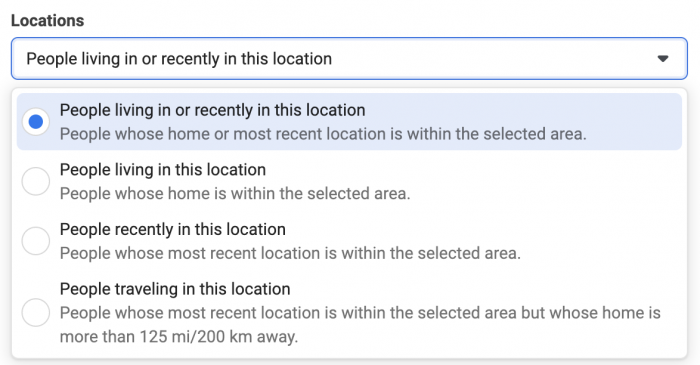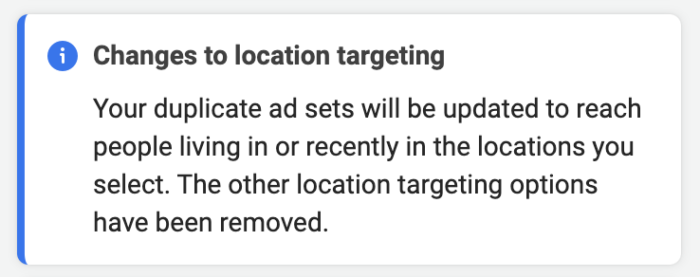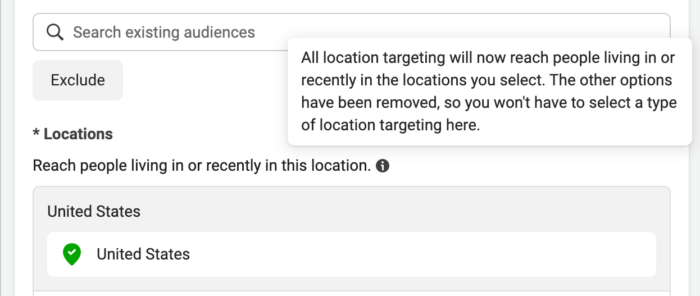Well, this was a bit of a surprise. Meta made an unannounced and rather drastic update to location targetingDefault location targeting will include anyone living in or recently in your home country. You can target and exclude locations by country, state, region, city, zip code, and more. In 2023, Meta removed options to target people only living in, traveling in, or recently in a location. More.
Let’s review how things were before, how things are now, and how this impacts advertising.
How Things Were Before
It’s possible you still have this. If not, this was how location targeting worked in the “good old days.”

The default was “Living in or recently in this location.” In other words, if you didn’t make any changes to that drop-down, you’d reachReach measures the number of Accounts Center Accounts (formerly users) that saw your ads at least once. You can have one account reached with multiple impressions. More people who live in the locations you select or were recently there, even though that’s not their home.
But you could select from four total options:
- People living in or recently in this location
- People living in this location
- People recently in this location
- People traveling in this location
How Things Are Now
This is one of those things that a lot of advertisers don’t touch, so it would be easy to miss. But I often use “Living in” for my ads. If I’m targeting a certain country, I want to make sure to only reach people who live in that country.
When I duplicated an ad set that was using this selection, I received an error message.

And now, this is what I see in the Locations area…

There is no more dropdown menu. It’s simply “Living in or recently in this location.” And this message is clear that this is now the only option and “the other options have been removed, so you won’t have to select a type of location targeting” anymore.
I’m not seeing any exceptions for objectiveWhen you create a campaign, one of the first things you'll do is select an objective. The campaign objective is your ultimate goal. Your selection will impact options, including optimization and delivery. Options include Awareness, Traffic, Engagement, Leads, App Promotion, and Sales. More or optimizationThe Performance Goal is chosen within the ad set and determines optimization and delivery. How you optimize impacts who sees your ad. Meta will show your ad to people most likely to perform your desired action. More.
I also checked Meta’s documentation. While it doesn’t mention a change, it also seems to be updated to reflect this new approach.

There is no mention of the old options.
Why Does This Matter?
For many advertisers, this won’t matter. You may not have even known that this was an option. I used “Living in,” but the truth is that I’ll be fine. I doubt I’ll notice any difference due to this change.
But, that’s not necessarily the case for everyone…
Here are a few important cases to keep in mind where this might matter:
1. Cannot ship outside of a particular location.
Let’s say that you can only ship to customers in the US. Or maybe there’s an alcohol law that differs by state (is that a thing?). If location targeting includes people who were “recently in” this location, you will spend money on people who visited there recently but aren’t eligible for shipping.
2. Politics, government, and schools.
Think about the things that only mean something to a resident. If you’re visiting a city, your kids won’t go to school there. You won’t vote for their elected officials. Paying to reach those people is a waste of money.
3. Services for homeowners.
Think about all of the service businesses that would only have local residents as customers. If you are visiting, you won’t have a need for a roofer, plumber, painter, or flooring company. You would want to pay to reach only those who live in a certain area.
4. Tourism.
If you cater to tourists, you likely used the “Traveling in this location” option. You have no use for locals. But now, you’ll be forced to reach everyone who is in the area — or was recently in the area. That’s not helpful.
Why Was This Change Needed?
Without an official statement (I haven’t seen one), I can only make some guesses. Here are a few possibilities…
1. No one used it anyway.
Of course, some people did. But Meta is notorious for removing helpful features that a minority of advertisers used (see Inspect Tool and Conditional Formatting).
2. Privacy concerns.
The perception could be bad that advertisers are able to target people based on their immediate location, not just on what they put in their profile as their home city. This could be due to the scrutiny that Meta continues to be under in this area.
3. The algorithm will sort it out.
Maybe we’re overthinking this. This could be like how going broad can have better results than targeting by interest, a lookalike audienceLookalike audiences allow advertisers to reach people who are similar to an audience of people already close to you. Lookalike audiences are based on custom Audiences, which tend to include your current customers or people who have engaged with your business. More, or even (sometimes) custom audienceThis is the group of people who can potentially see your ads. You help influence this by adjusting age, gender, location, detailed targeting (interests and behaviors), custom audiences, and more. More. It took some adjustment. But the algorithm is super smart. The same goes for using all placements (in most cases) instead of manually selecting them.
In theory, the algorithm will learn from what’s working and what’s not. So, maybe you can’t indicate that you only want local residents, but the algorithm realizes that this is one of the most important characteristics. You just won’t know that the algorithm knows.
Truthfully, it could be a combination of these three things.
How This Impacts Running CampaignsThe campaign is the foundation of your Facebook ad. This is where you'll set an advertising objective, which defines what you want your ad to achieve. More
Again, I’m not aware of an official statement from Meta on this, so I’m making some assumptions based on what I’ve seen and how things have worked before.
Based on everything I see, any ad set that customizes location targeting and is running right now isn’t impacted.
If you duplicate that ad set, though, the new ad set will have the new settings without a drop-down menu. And any new ad set you create will also reflect the new method.
Presumably, the currently running campaigns using the old method will have a deadline. That’s typically how these changes have worked in the past. Everything will run fine for now, but ad setsAn ad set is a Facebook ads grouping where settings like targeting, scheduling, optimization, and placement are determined. More using the old method will likely stop if not changed to “Living in or recently in” by a specific date.
That doesn’t mean you need to rush to change everything. It just means you should be aware of this possibility.
If this were to be the case, I’m sure we’ll hear something official from Meta eventually.
Your Turn
Do you customize location targeting? How does this impact you?
Let me know in the comments below!







